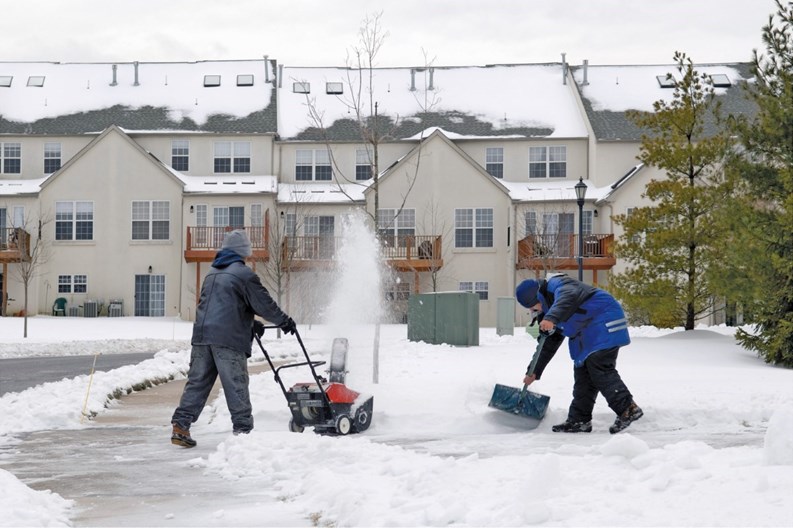Upon appearance, concrete may seem like a very dense material. However, in reality, it is like a sponge. It can and does absorb water. This can be easily observed on a summer day. Pouring water on a sidewalk, you may actually observe the water penetrate (be absorbed by) the surface of the concrete. Quality concrete should contain air voids.
Generally, all deicers work in the same way. They depress the freezing point of ice or snow and turn the mixture into a liquid or slush. Salts cut through ice or snow and form a salt water (brine) solution. This brine spreads under the ice or hard-packed snow and breaks the bond to the concrete surface. Once loose, the ice or snow can be easily removed by mechanical means. Or, in many cases, associations may apply the material in anticipation of ice or snow. This prevents the bond to the surface and melts the snow or ice as it comes in contact with the brine.
The melting action of the material allows water to enter the concrete. If the temperature then drops and the water freezes, the ice crystals can explode the concrete surface. This surface defect is commonly referred to as spalling or scalling.
The first measure of a deicer's effectiveness is the range of temperatures in which it can provide deicing action (in a reasonable time period). The lowest temperature limits for these materials is defined as effective (it melts the ice) within 15-20 minutes of application. Calcium Chloride works to temperatures to minus –25 degrees F. Sodium Chloride (Rock salt) works only to temperatures of 20 degrees F° resulting in a higher potential of freeze/thaw to occur and the crystal growth or expansion discussed above if temperatures fall below 20 degrees.
Don't Pour it On
Salt is often harmful to concrete surfaces, more frequently harmful on lower grades of concrete. During the first winter, deicers should not be used on concrete as the concrete may still be curing and containing excess water and as such less voids. The additional absorption of water from the ice melt and a freeze cycle may be just enough to cause a problem as the voids are full. Even when the concrete has cured, depending upon the mix (discussed below) a reaction may take place when rock salt is used. Some damage to plants can occur from excessive use of this material and care should be taken when applying the material.
Calcium Chloride is typically sold in the small pellets. This material is much more costly than rock salt, however, the concrete damage is less aggressive because it works at much lower temperatures, minimizing the freeze thaw cycle. Some damage to plants can occur from excessive use of this material and care should be taken when applying the material.
Potassium Chloride is much like Calcium Chloride and about the same cost. The difference is it's only less damaging to concrete. This material can also harm plants and metals (although less then the other materials) so care should be used when distributing it.
It should also be noted that some commercial de-icing compounds contain ammonium nitrite, nitrate or sulfate (fertilizers). You should never use these de-icing compounds since there is a moderate to rapid chemical reaction between these chemicals and almost all concrete.
Of course, as an alternate, sand can be used. The sand will not melt the snow and ice, but it will provide better traction.
Prevention Measures
Prevention of the spalling and scalling of concrete begins with the proper installation and finishing of the material.
Concrete for sidewalks should have a minimum compressive strength of 4,000 pounds (higher strength and/or reinforcement for driveways) per square inch and have proper air entrainment as well. Six percent air entrainment is common in this area of the country. Air entrainment allows for voids in the material for the expansion of water from freezing conditions to occur. Non-air entrained concrete will not have these voids and as such can spall or scale much more easily. The combination of strength and air is a good defense against deicer and salt damage. Concrete which is ordered, placed, finished, and cured properly (6 months or more) can resist years of contact with deicers or even rock salt.
In addition to the use of strong, air-entrained concrete, concrete installation should require a level, stable, and well compacted sub-base with good drainage under the slab. An allowance for thermal movement, contraction and subsequent expansion can be made by providing joints of required spacing and depth. Sawed or tooled contraction joints should be a minimum of ¼ the depth of the slab. Grades in the immediate area of the slabs should be set such that surface water is carried away from the slab so that the concrete is not kept continually saturated.
Many times, concrete surface failures such as spalling can be traced to workmanship deficiencies. The placement and finishing of the concrete is critical. The top surface of the concrete can be severely weakened by poor workmanship. Sometimes workers add water to concrete at the jobsite, use it as a finishing aid or improperly float the mix. This will dilute the amount of cement at the surface of the concrete and as such weaken the material. The cement is the element of concrete that binds the concrete materials. All finishing operations must be performed at the proper time. Any finishing operation should not be performed when free water is present on the surface of the concrete. Provide adequate curing conditions by retaining or supplying moisture (and heat in cold weather) for a sufficient length of time. Inadequate curing will prevent the concrete from realizing its full potential as to strength and durability. To resist the freeze/thaw action of water, strong concrete at the surface is needed. If concrete spalls or scales after the winter and deicers were not used, it must be a mix or a finishing problem. Concrete testing can verify this.
Some older communities looking to avoid the expense of replacing the concrete walkways turn to a coating or sealing approach. Be careful of sealing concrete with surface coatings that minimize or eliminate the possibility of water being absorbed by the concrete. Some of the coatings contain salines and siloxanes. These ingredients allow the clear coatings to “breathe.” This is an acceptable coating and can be effective only if applied correctly. Avoid using products that contain silicone or paraffin. These can produce a surface film. A film does not allow the concrete to breathe. Concrete typically absorbs water from the adjacent or subsurface soil. The water migrates through the concrete and eventually evaporates. However, if a film is present to trap the water at the surface, spalling may be the result during a freeze.
The Falcon Group, based in Bridgewater, New Jersey, provides professional engineering, design and architecture services to residential property owners, condominium and homeowner associations, and commercial institutions.







Leave a Comment